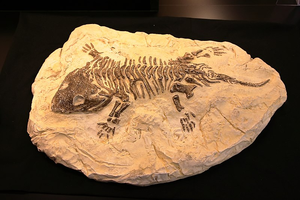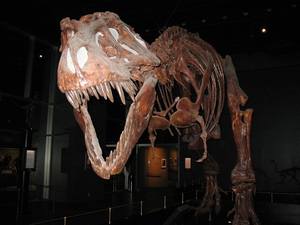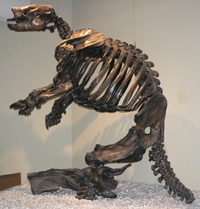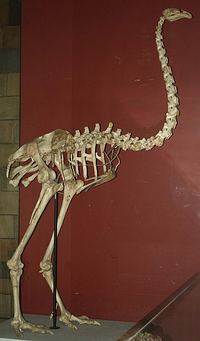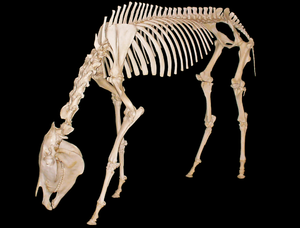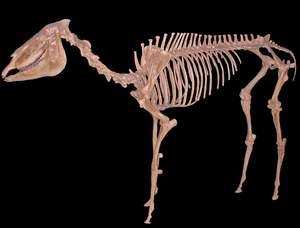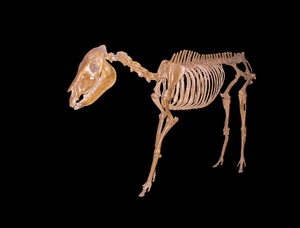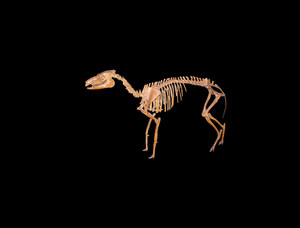Difference between revisions of "Fossil"
(→Evidence of Evolution) |
(→About Fossils) |
||
| Line 69: | Line 69: | ||
===About Fossils=== | ===About Fossils=== | ||
| − | : Most [[animal]] [[fossil]]s come from the [[bone]]s, [[teeth]] and | + | : Most [[animal]] [[fossil]]s come from the [[bone]]s, [[teeth]] and shells of [[animal]]s which have been trapped under layers of [[sedimentary]] [[rock]]. While there the biological material has been gradually replaced by [[mineral]]s turning it into [[rock]] over millions of years. |
| − | : Some [[fossil]]s are made when [[organism]]s become trapped in an [[anoxic]] environment where they cannot [[decay]] such as within | + | : Some [[fossil]]s are made when [[organism]]s become trapped in an [[anoxic]] environment where they cannot [[decay]] such as within amber, tar pits or under layers of [[ice]]. |
===Fossils as Evidence=== | ===Fossils as Evidence=== | ||
Revision as of 14:48, 3 April 2019
Contents
Key Stage 2
Meaning
A fossil is a piece of a dead creature that has turned into rock over millions of years.
About Fossils
- A fossil begins as a creature that dies and falls into mud or sand.
- Over millions of years the mud or sand turns into a rock with the creature trapped inside.
- The creature is replaced by minerals leaving a rock that is the same shape as the creature.
- In animals it is usually only the bone that becomes a fossil.
Evidence of Evolution
- Fossils show us many creatures that do not exist anymore.
| The Tyrannosaurus Rex is a dinosaur that became extinct 66 million years ago. | The Giant Sloth lived in North America and became extinct 10,000 years ago at the end of the last Ice Age. |
| The Dimetrodon became extinct long before the dinosaurs even existed. | The Moa has only been extinct for about 500 years. |
- Fossils appear slightly different as you dig into older rocks. When you dig far enough the oldest fossils look very different to the modern creatures.
|
|
|
|
Key Stage 3
Meaning
Fossils are the remains of a dead organisms that became trapped in sedimentary rock and turned into rock themselves over millions of years.
About Fossils
- Fossils are only found in sedimentary rocks but not in igneous rocks.
- It is very rare to find a complete fossil of a large animal. Most fossils of animals actually have the bones from lost of different members of the same species.
Key Stage 4
Meaning
Fossils are the remains of a dead organisms that became trapped in sedimentary rock and turned into rock themselves over millions of years.
About Fossils
- Most animal fossils come from the bones, teeth and shells of animals which have been trapped under layers of sedimentary rock. While there the biological material has been gradually replaced by minerals turning it into rock over millions of years.
- Some fossils are made when organisms become trapped in an anoxic environment where they cannot decay such as within amber, tar pits or under layers of ice.
Fossils as Evidence
- Fossils are one of the lines of scientific evidence for evolution.
- Since sedimentary rocks build up in layers over time fossils found in deeper layers are from further in the past. This can be used to date the fossils telling us when the organism died.
- Fossils provide a number of transitional forms showing how some speciess which are not extinct gradually evolved over time to form the species that are alive today.
- The fossil record is not complete as fossilisation is a rare process, so very few organisms become fossils after death. However, there are enough records to show clear evidence of evolution.
